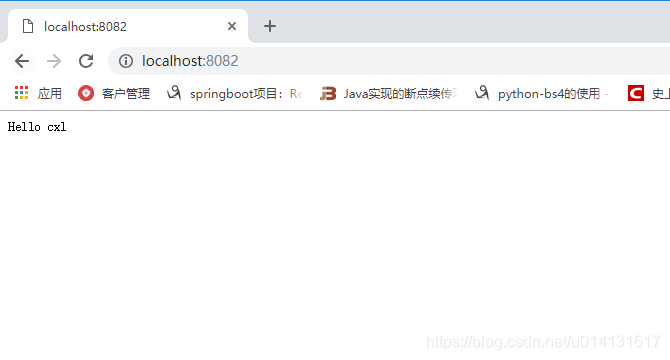版权声明:技术交流群:758191639 作者支付宝18696232390喜欢的可以打钱! https://blog.csdn.net/u014131617/article/details/86473629
1.需求
客户端发送一个请求,服务端响应hello cxl
2.创建项目
1.maven依赖
<dependency>
<groupId>io.netty</groupId>
<artifactId>netty-all</artifactId>
<version>4.1.25.Final</version>
</dependency>
2.创建主启动类
package com.cxl.netty;
import io.netty.bootstrap.ServerBootstrap;
import io.netty.channel.ChannelFuture;
import io.netty.channel.EventLoopGroup;
import io.netty.channel.epoll.EpollEventLoopGroup;
import io.netty.channel.nio.NioEventLoopGroup;
import io.netty.channel.socket.nio.NioServerSocketChannel;
/**
* 实现客户端发送一个请求,服务器会返回hello netty
* @author mingliang
*
*/
public class HelloServer {
public static void main(String[] args) throws InterruptedException {
//定义一对线程组
//主线程组
EventLoopGroup bossGroup = new NioEventLoopGroup();
//从线程组
EventLoopGroup workerGroup = new NioEventLoopGroup();
try {
//netty服务器的创建,ServerBootstrap启动类
ServerBootstrap serverBootstrap = new ServerBootstrap();
serverBootstrap.group(bossGroup,workerGroup) // 设置主从线程组
.channel(NioServerSocketChannel.class) // 设置NIO的双向通道
.childHandler(new HelloServerInitializer()); //子处理器,用于处理workgroup
//启动server并且设置9099为启动的端口号,并且启动方式为同步
ChannelFuture channelFuture =
serverBootstrap.bind(8082).sync(); //绑定端口,设置同步方式
channelFuture.channel().closeFuture().sync();
} finally {
bossGroup.shutdownGracefully();
workerGroup.shutdownGracefully();
}
}
}
3.创建初始化类
package com.cxl.netty;
import io.netty.channel.ChannelInitializer;
import io.netty.channel.ChannelPipeline;
import io.netty.channel.socket.SocketChannel;
import io.netty.handler.codec.http.HttpServerCodec;
/**
* 初始化器,channel注册后,会执行里面的相应的初始化方法
* @author mingliang
*
*/
public class HelloServerInitializer extends ChannelInitializer<SocketChannel>{
@Override
protected void initChannel(SocketChannel channel) throws Exception {
//通过SocketChannel去获取对应的管道
ChannelPipeline pipeline = channel.pipeline();
//通过管道,添加handler
//HttpServerCodec 是netty提供的助手类,可以理解拦截器
//当请求到服务端我们需要做编解码,响应到客户端做编码
pipeline.addLast("HttpServerCodec",new HttpServerCodec());
//添加自定义的助手类,返回hello cxl
pipeline.addLast("customHandler",new CustomHandler());
}
}
4.创建拦截器
package com.cxl.netty;
import java.nio.charset.Charset;
import java.nio.charset.CharsetEncoder;
import io.netty.buffer.ByteBuf;
import io.netty.buffer.Unpooled;
import io.netty.channel.Channel;
import io.netty.channel.ChannelHandlerContext;
import io.netty.channel.SimpleChannelInboundHandler;
import io.netty.handler.codec.http.DefaultFullHttpResponse;
import io.netty.handler.codec.http.FullHttpResponse;
import io.netty.handler.codec.http.HttpHeaderNames;
import io.netty.handler.codec.http.HttpHeaders;
import io.netty.handler.codec.http.HttpObject;
import io.netty.handler.codec.http.HttpResponseStatus;
import io.netty.handler.codec.http.HttpStatusClass;
import io.netty.handler.codec.http.HttpVersion;
import io.netty.util.CharsetUtil;
/**
* 自定义handler
* @author mingliang
*
*/
//SimpleChannelInboundHandler 相当于入站
public class CustomHandler extends SimpleChannelInboundHandler<HttpObject>{
@Override
protected void channelRead0(ChannelHandlerContext ctx, HttpObject msg)
throws Exception {
Channel channel = ctx.channel();//获取当前channel
System.out.println(channel.remoteAddress()); //显示客户端的远程地址
//定义发送的数据消息
ByteBuf content = Unpooled.copiedBuffer("Hello cxl",CharsetUtil.UTF_8);
//构建一个http响应
FullHttpResponse response =
new DefaultFullHttpResponse
(HttpVersion.HTTP_1_1,
HttpResponseStatus.OK,
content);
response.headers().set(HttpHeaderNames.CONTENT_TYPE,"text/plain");
response.headers().set(HttpHeaderNames.CONTENT_LENGTH,content.readableBytes());
//把响应刷到客户端
ctx.writeAndFlush(response);
}
}
3.启动main方法
页面发送请求即可

